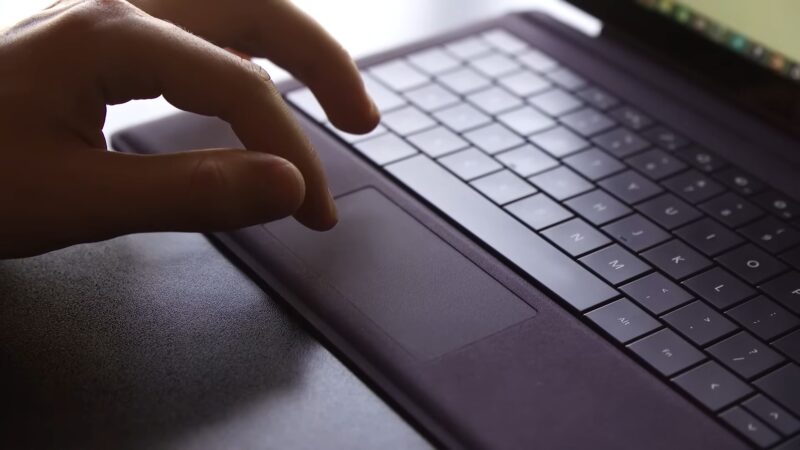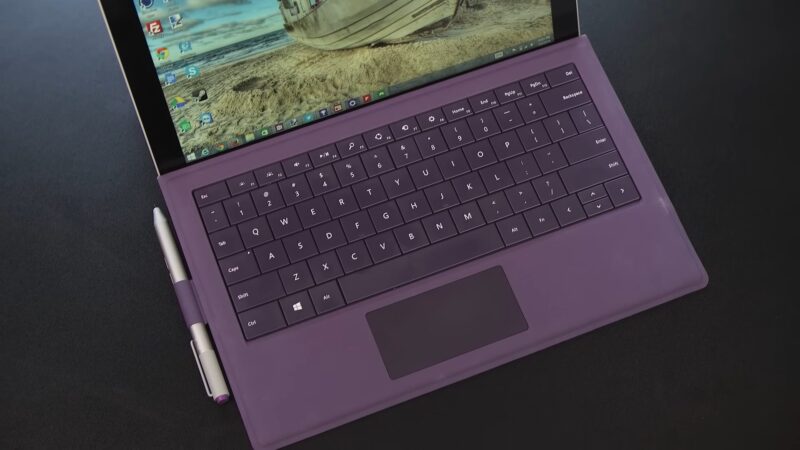The Surface Pro 3 is widely recognized as a powerful and versatile tablet computer, garnering love from countless users for its functionality. Despite its immense popularity, like all electronic gadgets, it’s not free from issues.
A frequently reported problem by users is the malfunctioning of the keyboard. Whether it’s not registering keystrokes or not powering on at all, such glitches can be particularly vexing.
Here, we will discuss the probable causes of this issue and offer a comprehensive guide to resolve it.
Main Reasons

1. Hardware Issues
A fundamental reason for the Surface Pro 3 keyboard malfunctioning often boils down to hardware-related issues. Let’s delve deeper into the potential causes:
- Misaligned or Loose Connection: Just like how any cable can come loose from its port, the same can happen with the Surface Pro 3 keyboard. Over time, or after frequent detaching and reattaching, the connection might not sit as snugly as it should, leading to intermittent or complete loss of function.
- Physical Damage: Physical traumas, such as dropping the keyboard, can cause internal components to break or displace. Even subtle damages like bent pins in the connection port can render the keyboard unusable.
- Faulty Keyboard Driver: Drivers act as the mediator between the hardware and the software. If there’s an issue with the keyboard driver, it might not correctly relay information, making it seem as though the keyboard itself is malfunctioning.
2. Software Issues
While the hardware forms the physical essence of the device, the software breathes life into it. Any discrepancies here can lead to the keyboard not working as intended. Some key software issues include:
- Windows OS Glitch: As the foundational software, if Windows encounters a glitch or error, it can manifest in multiple ways, one of which can be the keyboard not responding. Such issues might arise after a faulty update or software conflicts.
- Driver Malfunctions: As mentioned earlier, drivers are crucial for the proper functioning of hardware components. An outdated, corrupt, or incompatible driver can lead to the keyboard not being recognized or functioning erratically.
- Third-Party Application Conflicts: Occasionally, third-party software might conflict with system functions. For instance, some software might override keyboard controls or cause system resources to be used inefficiently, leading to keyboard lag or malfunction.
3. Dirt and Debris
It’s not just the software or the internal hardware that matters; the external environment also plays a significant role. The effects of dirt and debris are more pronounced due to the Surface Pro 3’s detachable nature:
- Disrupted Connections: Even a small amount of dirt in the connector port can prevent a secure connection. Over time, foreign particles can accumulate and impede the connector pins from making contact.
- Unresponsive or Sticky Keys: Spilled liquids, food particles, or general dust can seep between the keys, making them sticky or entirely unresponsive. Regular cleaning can prevent this, but once dirt is lodged in, it can be challenging to rectify without professional help.
Steps to Troubleshoot the Keyboard Issue

1. Examine the Hardware Connection
A seemingly simple yet often overlooked step, checking the hardware connection can save you hours of frustration. The detachable nature of the Surface Pro 3 keyboard means there’s potential for the connection to be compromised over time.
- Secure Connection: Ensure the keyboard connector aligns perfectly with the Surface Pro 3’s port. An improper connection might be the root cause of the malfunction.
- Detach and Reattach: Sometimes, a simple disconnection and reconnection can work wonders. It re-establishes the connection and can potentially clear minor obstructions.
- Test on Another Device: If the issue continues, try using the keyboard on a different Surface Pro 3. Should it work flawlessly on another device, the problem might be exclusive to your tablet. This can help you pinpoint whether the malfunction is device-specific.
2. Driver Updates
Drivers play a pivotal role in ensuring seamless communication between the hardware and software. Outdated or corrupt drivers can be a silent saboteur.
- Navigating to Updates: Access ‘Settings’ from the start menu. From there, proceed to ‘Update & Security’ and select ‘Windows Update’.
- Checking for Updates: Once in the Windows Update section, click on ‘Check for updates’. Your system will search for the latest updates available.
- Prioritize Hardware Updates: While it’s essential to keep your system updated overall, ensure that any updates specifically related to hardware or peripherals are installed promptly.
3. Reset the Keyboard
Sometimes, the keyboard’s internal software might be causing the glitches. Resetting it can help:
- Initiating Reset: Press the Ctrl, Windows, and Shift keys simultaneously. Following this, press the B key. This combination serves to reboot the keyboard.
- Post-reset Actions: After the reset, you might encounter prompts to set up the keyboard again. Follow through with the instructions to ensure the keyboard operates optimally.
4. Restore Operating System
Restoring the OS is akin to giving your Surface Pro 3 a fresh start. Before doing so, remember this step is more drastic and might result in data loss.
- Back-Up: Ensure all your vital data is backed up. This could be on a cloud service, external hard drive, or any other preferred method.
- Initiating Reset: Navigate to the ‘Recovery’ section by going to ‘Settings’, then ‘Update & Security’. Here, you’ll find the ‘Reset this PC’ option. Follow the prompts to start the restoration process.
Additional Tips to Consider

- Battery Health on Wireless Keyboards: If you’re using a wireless variant, the battery can often be the silent culprit. Ensure the batteries are neither drained nor have corroded over time. A fresh pair of batteries might be all you need.
- Experiment with USB Ports: Over time, USB ports can become faulty. By switching between different ports, you can identify if the problem lies with the port itself or the keyboard connection.
- Compatibility of Third-Party Keyboards: Not every keyboard is designed to be compatible with the Surface Pro 3. Before purchasing a third-party keyboard, double-check its compatibility to avoid potential conflicts.
- Power Button Check: This might seem overly basic, but sometimes the solution is as simple as ensuring the keyboard’s power button is engaged.
- Rebooting the Surface Pro 3: Many tech issues can be resolved with a good old-fashioned reboot. By restarting, you’re giving your system a fresh slate, potentially eliminating temporary software glitches.
- Disabling the ‘Touch Keyboard’: In some cases, the on-screen ‘Touch Keyboard’ might conflict with the physical one. Navigate to Windows settings and disable this feature to see if it improves keyboard responsiveness.
- Windows Troubleshooter for Keyboards: Windows has a suite of built-in troubleshooting tools. Access the troubleshooter and select the option specifically designed for keyboards. It will diagnose and offer solutions for common issues.
- Surface Pro 3 Firmware Updates: While drivers ensure smooth hardware-software interaction, firmware updates can enhance or fix hardware performance. Regularly check for Surface Pro 3 firmware updates to maintain optimal performance.
- Factory Reset: When all else fails, returning your Surface Pro 3 to its original factory settings can resolve deep-rooted software conflicts. Remember, this step will erase all your data, so back up essential files before proceeding.
FAQ
Why are the keys working in UEFI but not in Windows?
The problem might be with the software installed on the Surface. Consider reinstalling Windows or using a USB recovery drive for Surface.
What should I do if the touchpad or keypad is slow to respond?
Ensure that your Surface isn’t running slower than usual. Check for any software or background processes that might be causing the lag.
Why doesn’t the key I press match what shows on the screen?
Ensure that the language you’re using on your Keyboard matches the one you’re using on your PC. The Keyboard and display language should be the same for best typing results.
What should I do if the function, specialty, or media keys aren’t working as expected?
Refer to the guide on special keys and function keys for Surface Type Cover and Keyboards.
What steps should I take if there’s visible damage to my Surface Pro 3 Keyboard or Type Cover?
If keys are damaged, cracked, or have fallen off, it’s likely a hardware failure. Consider submitting a service order for your Type Cover or Keyboard.
Final Words
Navigating tech issues can be daunting, but armed with these comprehensive steps, you’re better equipped to identify and resolve keyboard problems on your Surface Pro 3. If solutions seem elusive, don’t hesitate to seek expert assistance.
Microsoft’s dedicated support team is always on standby to provide specialized help. Remember, the troubleshooting process isn’t just about finding solutions; it’s also a journey toward understanding your device more intimately.
Patience, persistence, and a systematic approach will often lead you to the answers you seek.






